In this guide, I will show how to install NVIDIA driver kernel Module CUDA, replace stock Pyrit, and install Cpyrit.At the end of this guide, you will be able to use GPU acceleration for enabled applications such as cudaHashcat, Pyrit, crunch etc. 
This guide replaces the old guide
This is part 2 of installing NVIDIA driver kernel Module CUDA and Pyrit on Kali Linux Driver series which was divided into two parts:
- Install proprietary NVIDIA driver on Kali Linux – NVIDIA Accelerated Linux Graphics Driver
- Install NVIDIA driver kernel Module CUDA and Pyrit on Kali Linux – CUDA, Pyrit and Cpyrit-cuda
You use the first guide to install NVIDIA Driver on Kali Linux. I would assume you followed the first guide and completed all steps there and would like to enable GPU acceleration, (cudahashcat, GPU pass through etc.) on your Kali Linux.
Table of Contents
CUDA Toolkit
The NVIDIA® CUDA® Toolkit provides a comprehensive development environment for C and C++ developers building GPU-accelerated applications. The CUDA Toolkit includes a compiler for NVIDIA GPUs, math libraries, and tools for debugging and optimizing the performance of your applications. You’ll also find programming guides, user manuals, API reference, and other documentation to help you get started quickly accelerating your application with GPUs. You can read a lot more here in NVIDIA Developers official webpage:
Prerequisites
Following are the prerequisite before you start following this guide:
Prerequisite 1: add Official Kali Linux repository.
I’ve added the correct Kali Official repositories and issued the following commands to update, upgrade and dist-upgrade my Kali Linux.
apt-get update && apt-get upgrade -y && apt-get dist-upgrade -y
Prerequisite 2: Install proprietary NVIDIA driver on Kali Linux
I’ve installed the correct official proprietary NVIDIA driver on Kali Linux – NVIDIA Accelerated Linux Graphics Driver using the previous guide:
If you’ve completed both, move to next instruction.
Step 1: Install NVIDIA CUDA toolkit and openCL
At first we need to install NVIDIA CUDA toolkit and NVIDIA openCL
aptitude install nvidia-cuda-toolkit nvidia-opencl-icd
This will install CUDA packages in your Kali Linux. The total package is pretty large including dependencies, (282MB something), you be patient and let it finish.
Step 2: Download Pyrit and Cpyrit
Download Pyrit and Cpyrit from the official website:
Save them in your /root folder.
Step 3: Install Pyrit
Follow the instructions below to install Pyrit and it’s prerequisites.
Step 3.a: Install Pyrit prerequisites
apt-get install python2.7-dev python2.7-libpcap libpcap-dev
Step 3.b: Remove existing installation of Pyrit
Remove stock Pyrit using the following command:
apt-get remove pyrit
You get a message stating that it will also remove kali-linux-full package. It actually doesn’t. All it does updating Kali repo and remove Pyrit. Finish removing Pyrit.
If you are not using a clean install of Kali (not recommended), you may need to issue the following command:
rm -r /usr/local/lib/python2.7/dist-packages/cpyrit/
Step 3.c: Install new Pyrit
Copy paste the following commands to extract downloaded Pyrit in your Kali Linux /root directory
tar -xzf pyrit-0.4.0.tar.gz cd pyrit-0.4.0
Now build the package
python setup.py build
Once build is complete, you can install Pyrit.
python setup.py install
Up to this point, you shouldn’t receive any errors.
Step 4: Install CPyrit-cuda
Copy paste the following commands to extract downloaded CPyrit-cuda in your Kali Linux /root directory
tar -xzf cpyrit-cuda-0.4.0.tar.gz cd cpyrit-cuda-0.4.0
Now build the package
python setup.py build
Once build is complete, you can install CPyrit-cuda.
python setup.py install
Again, you shouldn’t receive any errors, if there’s error, go back and review each steps.
Step 5: Testing and troubleshooting
Now that we’ve installed NVIDIA driver kernel Module CUDA and Pyrit on Kali Linux, we should be able to test it. The best way to test is by issuing the following command:
pyrit list_cores
This gave me an error “ bash: /usr/bin/pyrit: No such file or directory “.
It seems this Pyrit puts its binaries in wrong folder than you’d expect. The actual path for Pyrit is now /usr/local/bin/pyrit
Step 5.a Softlink them or add path to profile
There’s two different ways you can resolve it. You can either softlink or add this /usr/local/bin/ path to your profile. Choice is again yours.
Step 5.a.i: Softlinking
ln -s /usr/local/bin/pyrit /usr/bin/pyrit
Step 5.a.ii: Add path
If you want only to specific user edit ~/.bash_profile or ~/.bashrc and put there
export PATH=$PATH:/usr/local/bin
If you want for all users edit /etc/profile and scroll down until you see something like
PATH="/bin:/usr/bin:/sbin:/usr/sbin" export PATH
Append to the end /usr/local/bin. it will be
PATH="/bin:/usr/bin:/sbin:/usr/sbin:/usr/local/bin"
and Finally
Once you’ve either Softlinked or added the correct path to your profile, then following is what you get
root@kali:~# pyrit list_cores Pyrit 0.4.0 (C) 2008-2011 Lukas Lueg http://pyrit.googlecode.com This code is distributed under the GNU General Public License v3+ The following cores seem available... #1: 'CUDA-Device #1 'GeForce 210'' #2: 'CPU-Core (SSE2)' #3: 'CPU-Core (SSE2)' #4: 'CPU-Core (SSE2)'
and of course I did a benchmark with my GeForce 210 card:
root@kali:~# pyrit benchmark Pyrit 0.4.0 (C) 2008-2011 Lukas Lueg http://pyrit.googlecode.com This code is distributed under the GNU General Public License v3+ Running benchmark (2744.1 PMKs/s)... - Computed 2744.11 PMKs/s total. #1: 'CUDA-Device #1 'GeForce 210'': 853.1 PMKs/s (RTT 3.0) #2: 'CPU-Core (SSE2)': 648.1 PMKs/s (RTT 2.8) #3: 'CPU-Core (SSE2)': 647.6 PMKs/s (RTT 2.9) #4: 'CPU-Core (SSE2)': 658.5 PMKs/s (RTT 3.0) root@kali:~#
Conclusion
Pyrit allows to create massive databases, pre-computing part of the IEEE 802.11 WPA/WPA2-PSK authentication phase in a space-time-tradeoff. Exploiting the computational power of Many-Core- and other platforms through ATI-Stream, Nvidia CUDA and OpenCL, it is currently by far the most powerful attack against one of the world’s most used security-protocols.
Here’s a great benchmark done with Pyrit and CUDA for different GPU’s
Thanks for reading. If this guide helped you to install NVIDIA driver kernel Module CUDA and Pyrit on Kali Linux – CUDA, Pyrit and Cpyrit-cuda, please share this article and follow me in Facebook/Twitter.
ah and don’t forget to show off your Pyrit Benchmark. ;)

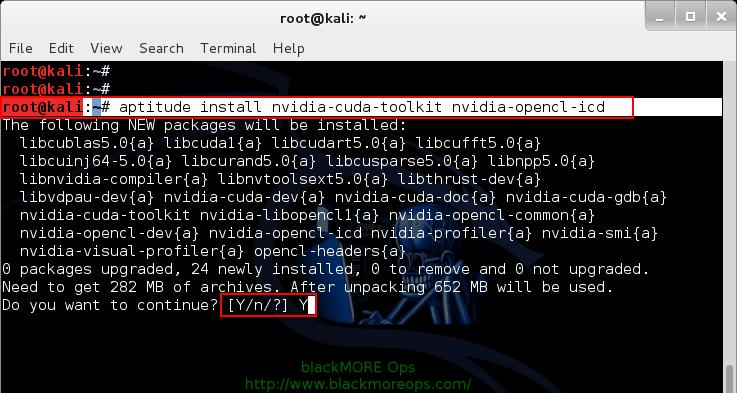
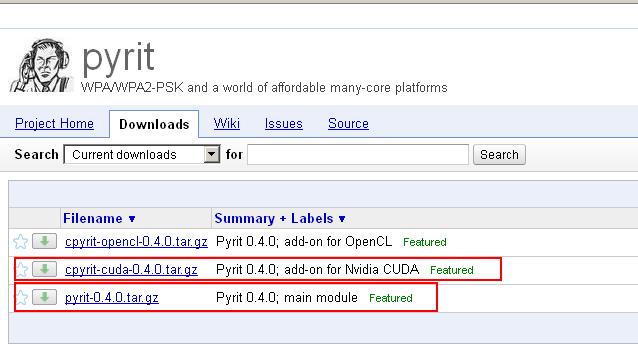
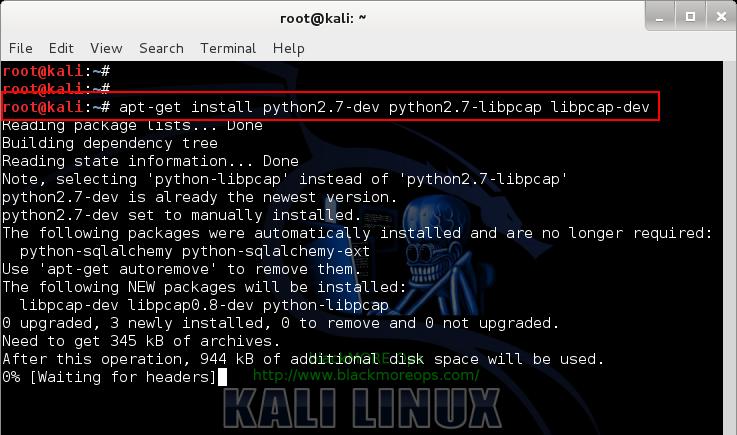
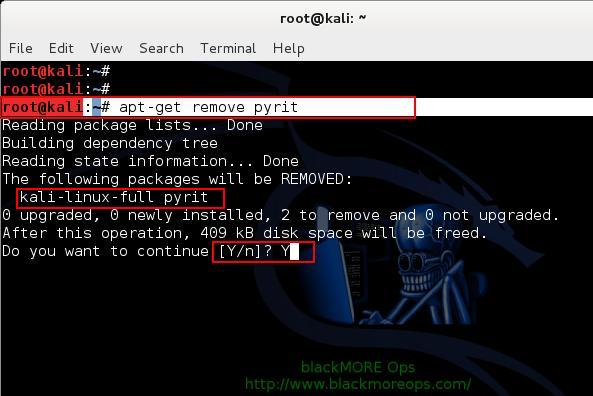
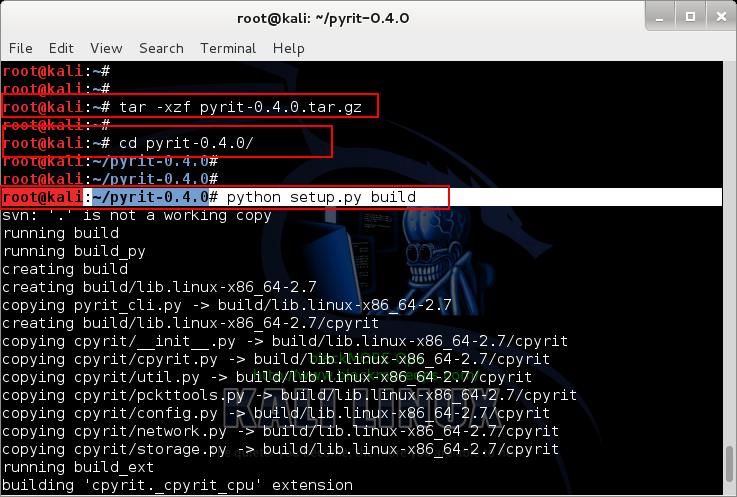
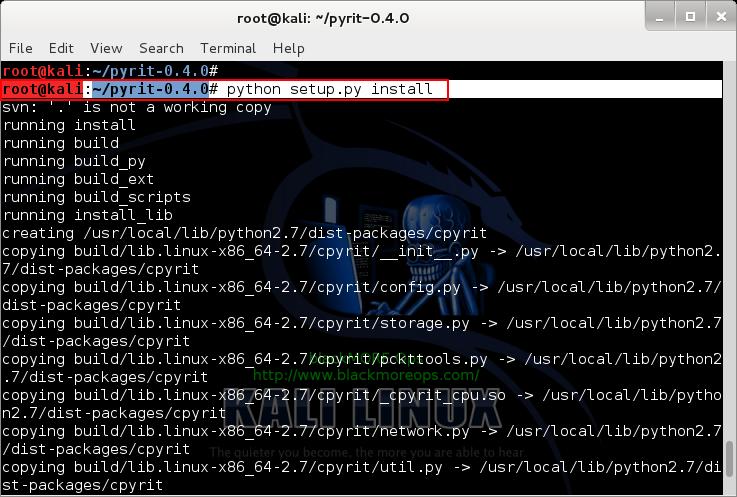
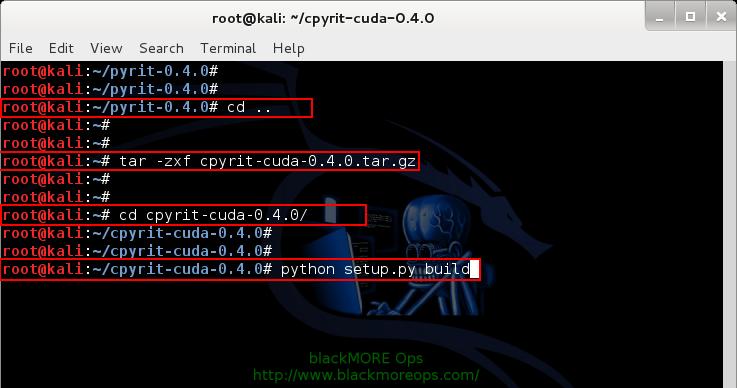
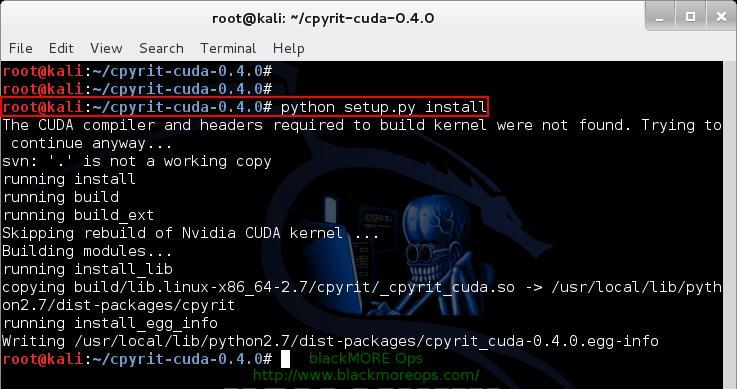
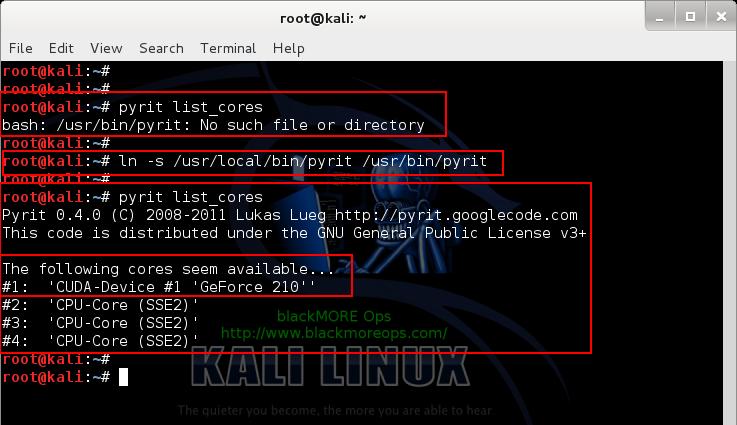
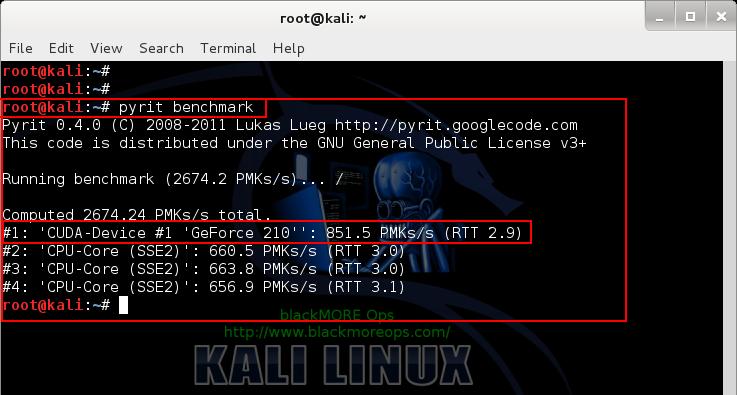
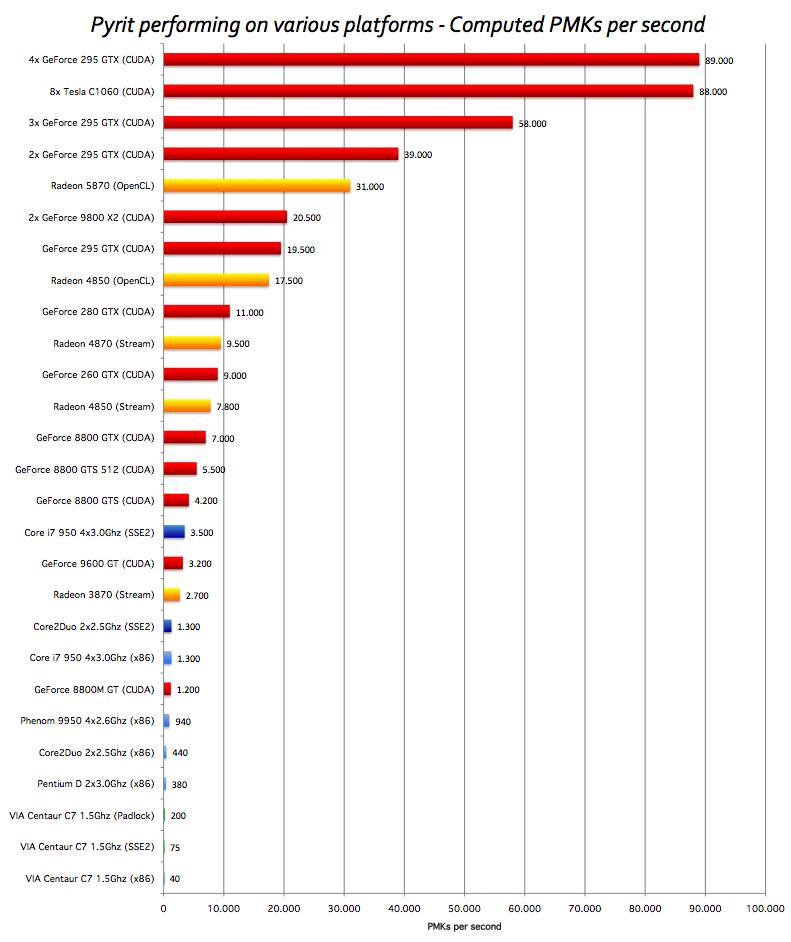
92 comments
root@jok3R:~# pyrit benchmark
Pyrit 0.4.0 (C) 2008-2011 Lukas Lueg http://pyrit.googlecode.com
This code is distributed under the GNU General Public License v3+
Running benchmark (5525.5 PMKs/s)… –
Computed 5525.47 PMKs/s total.
#1: ‘CUDA-Device #1 ‘GeForce 8800 GT”: 5436.3 PMKs/s (RTT 2.8)
#2: ‘CPU-Core (SSE2)’: 641.5 PMKs/s (RTT 3.0)
root@jok3R:~#
pyrit benchmark
Pyrit 0.4.0 (C) 2008-2011 Lukas Lueg http://pyrit.googlecode.com
This code is distributed under the GNU General Public License v3+
Running benchmark (3889.1 PMKs/s)… \
Computed 3889.13 PMKs/s total.
#1: ‘CUDA-Device #1 ‘GeForce GT 610”: 2963.2 PMKs/s (RTT 2.8)
#2: ‘CPU-Core (SSE2)’: 407.7 PMKs/s (RTT 3.0)
#3: ‘CPU-Core (SSE2)’: 412.3 PMKs/s (RTT 3.0)
#4: ‘CPU-Core (SSE2)’: 413.4 PMKs/s (RTT 3.0)
Computed 121397.62 PMKs/s total.
#1: ‘CUDA-Device #1 ‘GeForce GTX 980”: 86842.2 PMKs/s (RTT 1.5)
#2: ‘CUDA-Device #2 ‘GeForce GTX 770”: 29292.5 PMKs/s (RTT 3.0)
#3: ‘CPU-Core (SSE2)’: 748.5 PMKs/s (RTT 3.0)
#4: ‘CPU-Core (SSE2)’: 729.1 PMKs/s (RTT 3.0)
#5: ‘CPU-Core (SSE2)’: 744.1 PMKs/s (RTT 3.0)
#6: ‘CPU-Core (SSE2)’: 751.2 PMKs/s (RTT 3.0)
#7: ‘CPU-Core (SSE2)’: 744.5 PMKs/s (RTT 3.0)
#8: ‘CPU-Core (SSE2)’: 742.0 PMKs/s (RTT 3.0)
#9: ‘CPU-Core (SSE2)’: 728.2 PMKs/s (RTT 3.0)
#10: ‘CPU-Core (SSE2)’: 744.8 PMKs/s (RTT 3.0)
#11: ‘CPU-Core (SSE2)’: 738.3 PMKs/s (RTT 3.0)
#12: ‘CPU-Core (SSE2)’: 739.7 PMKs/s (RTT 3.0)
Hi Blackmore,
Will this guide work on Kali 1.10? Just curious. Your 1.08 install nvidia drivers does work on 1.10 also. Only difference was the PCI address.
Anyway thanks for your guides, Linux noobs like me really appreciate them
Got brave and tried it.
Only problem was the python part. Kali 1.10 already comes with higher python ver 2.73. So because I’m a noob and didnt know if I could skip that step, I just installed older python. Then continued to follow the guide. It worked, mostly.
Only thing is I’m getting random freezing especially at startup. Freezing seems to get better over time. Mostly annoying but usable. Probably caused by a conflict Blackmore’s new guide will fix.
root@kali:~# pyrit benchmark
Pyrit 0.4.0 (C) 2008-2011 Lukas Lueg http://pyrit.googlecode.com
This code is distributed under the GNU General Public License v3+
Running benchmark (33713.0 PMKs/s)… –
Computed 33712.99 PMKs/s total.
#1: ‘CUDA-Device #1 ‘GeForce GTX 580M”: 16701.7 PMKs/s (RTT 2.9)
#2: ‘CUDA-Device #2 ‘GeForce GTX 580M”: 16615.8 PMKs/s (RTT 2.9)
#3: ‘CPU-Core (SSE2)’: 427.6 PMKs/s (RTT 3.2)
#4: ‘CPU-Core (SSE2)’: 433.2 PMKs/s (RTT 3.4)
#5: ‘CPU-Core (SSE2)’: 434.3 PMKs/s (RTT 3.2)
#6: ‘CPU-Core (SSE2)’: 450.8 PMKs/s (RTT 3.3)
#7: ‘CPU-Core (SSE2)’: 443.7 PMKs/s (RTT 3.1)
#8: ‘CPU-Core (SSE2)’: 430.8 PMKs/s (RTT 3.2)
Thanks blackmore, looking forward to official kali 1.10/cuda guide.
Pyrit 0.4.0 (C) 2008-2011 Lukas Lueg http://pyrit.googlecode.com
This code is distributed under the GNU General Public License v3+
Running benchmark (32356.8 PMKs/s)… \
Computed 32356.75 PMKs/s total.
#1: ‘CUDA-Device #1 ‘GeForce GTX 570”: 31953.8 PMKs/s (RTT 2.8)
#2: ‘CPU-Core (SSE2)’: 917.8 PMKs/s (RTT 3.1)
#3: ‘CPU-Core (SSE2)’: 892.7 PMKs/s (RTT 3.0)
#4: ‘CPU-Core (SSE2)’: 909.5 PMKs/s (RTT 3.1)
Did you manage to get cudahashcat work as well?
Thanks for the tutorial. These are PMKs for the following laptop:
Lenovo ThinkPad W530
32 GB ram
Intel Core i7-3940XM @ 3.00GHzx8
Ubuntu 15.04
Not too shabby for a laptop.
Pyrit 0.4.0 (C) 2008-2011 Lukas Lueg http://pyrit.googlecode.com
This code is distributed under the GNU General Public License v3+
Running benchmark (10236.5 PMKs/s)… –
Computed 10236.46 PMKs/s total.
#1: ‘CUDA-Device #1 ‘Quadro K2000M”: 8132.8 PMKs/s (RTT 2.8)
#2: ‘CPU-Core (SSE2)’: 430.5 PMKs/s (RTT 3.3)
#3: ‘CPU-Core (SSE2)’: 432.6 PMKs/s (RTT 3.2)
#4: ‘CPU-Core (SSE2)’: 428.0 PMKs/s (RTT 3.2)
#5: ‘CPU-Core (SSE2)’: 445.1 PMKs/s (RTT 3.3)
#6: ‘CPU-Core (SSE2)’: 432.9 PMKs/s (RTT 3.2)
#7: ‘CPU-Core (SSE2)’: 423.6 PMKs/s (RTT 3.3)
#8: ‘CPU-Core (SSE2)’: 425.6 PMKs/s (RTT 3.3)
How can I fix?
lspci -nn | grep VGA
01:00.0 VGA compatible controller [0300]: NVIDIA Corporation Device [10de:1187]
had me worried but even though it says that …. it works your tutorial is great thanks a million
pyrit benchmark
Pyrit 0.4.0 (C) 2008-2011 Lukas Lueg http://pyrit.googlecode.com
This code is distributed under the GNU General Public License v3+
Running benchmark (27322.1 PMKs/s)… –
Computed 27322.05 PMKs/s total.
#1: ‘CUDA-Device #1 ‘GeForce GTX 760”: 24507.5 PMKs/s (RTT 2.8)
#2: ‘CPU-Core (SSE2)’: 672.5 PMKs/s (RTT 3.0)
#3: ‘CPU-Core (SSE2)’: 674.9 PMKs/s (RTT 3.0)
#4: ‘CPU-Core (SSE2)’: 689.6 PMKs/s (RTT 2.9)
#5: ‘CPU-Core (SSE2)’: 685.9 PMKs/s (RTT 3.0)
#6: ‘CPU-Core (SSE2)’: 667.7 PMKs/s (RTT 3.0)
#7: ‘CPU-Core (SSE2)’: 685.9 PMKs/s (RTT 3.0)
#8: ‘CPU-Core (SSE2)’: 683.8 PMKs/s (RTT 3.0)
^^^
just wish i knew how to backup so if anything happens i can reinstall to this point where all is good plz help if anyone has link been searching for ways for few days
root@alien-sana:~# pyrit benchmark
Pyrit 0.4.0 (C) 2008-2011 Lukas Lueg http://pyrit.googlecode.com
This code is distributed under the GNU General Public License v3+
Running benchmark (82806.5 PMKs/s)… |
Computed 82806.46 PMKs/s total.
#1: ‘OpenCL-Device ‘GeForce GTX 690”: 43786.3 PMKs/s (RTT 2.9)
#2: ‘OpenCL-Device ‘GeForce GTX 690”: 43728.8 PMKs/s (RTT 2.8)
#3: ‘CPU-Core (SSE2)’: 722.6 PMKs/s (RTT 3.2)
#4: ‘CPU-Core (SSE2)’: 761.8 PMKs/s (RTT 2.8)
#5: ‘CPU-Core (SSE2)’: 735.8 PMKs/s (RTT 3.0)
#6: ‘CPU-Core (SSE2)’: 671.8 PMKs/s (RTT 3.0)
#7: ‘CPU-Core (SSE2)’: 670.6 PMKs/s (RTT 3.0)
#8: ‘CPU-Core (SSE2)’: 773.0 PMKs/s (RTT 3.0)
root@alien-sana:~# lspci -nn | grep VGA
04:00.0 VGA compatible controller [0300]: NVIDIA Corporation GK104 [GeForce GTX 690] [10de:1188] (rev a1)
root@alien-sana:~# uname -a
Linux alien-sana 4.0.0-kali1-amd64 #1 SMP Debian 4.0.4-1+kali2 (2015-06-03) x86_64 GNU/Linux
Thank you for the tutorial
kali:~# pyrit benchmark
Pyrit 0.4.0 (C) 2008-2011 Lukas Lueg http://pyrit.googlecode.com
This code is distributed under the GNU General Public License v3+
Running benchmark (10021.2 PMKs/s)… \
Computed 10021.22 PMKs/s total.
#1: ‘CUDA-Device #1 ‘GeForce GTX 460M”: 9427.3 PMKs/s (RTT 2.8)
#2: ‘CPU-Core (SSE2)’: 416.2 PMKs/s (RTT 2.9)
#3: ‘CPU-Core (SSE2)’: 415.4 PMKs/s (RTT 2.9)
#4: ‘CPU-Core (SSE2)’: 426.4 PMKs/s (RTT 3.0)
Any idea why I get the error when building it?
root@localhost:~/pyrit-0.4.0# python setup.py build
svn: E155007: ‘/root/pyrit-0.4.0’ is not a working copy
running build
running build_py
running build_ext
building ‘cpyrit._cpyrit_cpu’ extension
x86_64-linux-gnu-gcc -pthread -DNDEBUG -g -fwrapv -O2 -Wall -Wstrict-prototypes -fno-strict-aliasing -D_FORTIFY_SOURCE=2 -g -fstack-protector-strong -Wformat -Werror=format-security -fPIC -I/usr/include/python2.7 -c cpyrit/_cpyrit_cpu.c -o build/temp.linux-x86_64-2.7/cpyrit/_cpyrit_cpu.o -Wall -fno-strict-aliasing -DVERSION=”0.4.0″
cpyrit/_cpyrit_cpu.c:35:26: fatal error: openssl/hmac.h: No such file or directory
#include <openssl/hmac.h>
^
compilation terminated.
error: command ‘x86_64-linux-gnu-gcc’ failed with exit status 1
I also have the same error trying to build pyrit on Kali Linux 2.0 with kernel 4.0.0-kali1-amd64.
Same here
I am also having this issue!
I had the same issue.
This solves it:
apt-get install libssl-dev
apt-get install linux-headers-$(uname -r)
Thanks Cypone! It worked! :D
root@kali:~# pyrit benchmark
Pyrit 0.4.0 (C) 2008-2011 Lukas Lueg http://pyrit.googlecode.com
This code is distributed under the GNU General Public License v3+
Running benchmark (84597.3 PMKs/s)… |
Computed 84597.32 PMKs/s total.
#1: ‘CUDA-Device #1 ‘GeForce GTX 970”: 87705.5 PMKs/s (RTT 1.4)
#2: ‘CPU-Core (SSE2)’: 999.4 PMKs/s (RTT 3.0)
#3: ‘CPU-Core (SSE2)’: 1032.8 PMKs/s (RTT 2.9)
#4: ‘CPU-Core (SSE2)’: 1018.6 PMKs/s (RTT 2.9)
i5 [email protected] +GTX 970 results.
Thank you, this fixed my issue!
Hi Cypone,
Looks like others were having same issue and your fix worked for them as well. Thanks for sharing. Cheers,
-BMO
Running benchmark (3662.1 PMKs/s)… /
Computed 3662.13 PMKs/s total.
#1: ‘CUDA-Device #1 ‘NVS 4200M”: 2709.9 PMKs/s (RTT 2.8)
#2: ‘CPU-Core (SSE2)’: 433.7 PMKs/s (RTT 3.1)
#3: ‘CPU-Core (SSE2)’: 429.3 PMKs/s (RTT 3.3)
#4: ‘CPU-Core (SSE2)’: 468.4 PMKs/s (RTT 3.2)
First try! Also did this on my Macbook pro with your ati tutorial and ended very very well :) First try for both! Hoping to get into the 10,000pmk range after hashcat! Thanks again Blackmoreops! You rock the kali world to the core!! These current benchmarks on my I7 Lenovo thinkpad t420s NVS4200 Nvidia laptop. !!! If anyone needs personal help feel free to ask me also, this site is a great help!
Here, try my maintained version and tell me what you think:
https://github.com/JPaulMora/Pyrit
thanks!
root@admin:~/cpyrit-cuda-0.4.0# pyrit list_cores
Pyrit 0.4.0 (C) 2008-2011 Lukas Lueg http://pyrit.googlecode.com
This code is distributed under the GNU General Public License v3+
The following cores seem available…
#1: ‘CUDA-Device #1 ‘GeForce GTX 760”
#2: ‘CPU-Core (SSE2)’
#3: ‘CPU-Core (SSE2)’
#4: ‘CPU-Core (SSE2)’
#5: ‘CPU-Core (SSE2)’
#6: ‘CPU-Core (SSE2)’
Thanks man, when building the python files for pyrit I was getting an error. Did a little research and ran this line:
apt-get install libssl-dev python-dev python-scapy
For me some reason I needed the python-scapy, after that it worked perfect. Hope this helps anyone who had my problem.
Very nice upgrade. I’ve added my nvidia quadro K600 display card’s processing power to an Intel XEON E-3 CPU in a Lenovo Thinkstation. I was at about 5300 PMKs/sec with just the 8 core CPU, but adding the GPU in has pushed it up to 8066 PMKs/sec so far in a brute-force test. I had python build errors, initially, and was then able to review comments at the pyrit website, where I discovered nvidia-toolkit and libssl-dev were missing prerequisites. Also, a tip- watch your “/” filesystem space. If you’re on a usb key like me, KALI may have undersized it. The NVIDIA components eat up space. I had to resize logical volumes and filesystems, so that install of libssl-dev could proceed.
Curious question… just began fiddling with the new “Sana” version of Kali 2.0 and am wondering which of the two to download from the Cuda Toolkit page… for Ubuntu 15.04 or 14.04? Sorry n00b question. I’m just not sure where “Sana” falls or how to find that out. Cheers!
help please, bit of a noob here, everything seemed to have installed ok but on checking the cores i get this
ure release.
Building modules…
building ‘cpyrit._cpyrit_cuda’ extension
creating build
creating build/temp.linux-x86_64-2.7
x86_64-linux-gnu-gcc -pthread -DNDEBUG -g -fwrapv -O2 -Wall -Wstrict-prototypes -fno-strict-aliasing -D_FORTIFY_SOURCE=2 -g -fstack-protector-strong -Wformat -Werror=format-security -fPIC -I/usr/include/python2.7 -c _cpyrit_cuda.c -o build/temp.linux-x86_64-2.7/_cpyrit_cuda.o -Wall -fno-strict-aliasing -DVERSION=”0.4.0″
creating build/lib.linux-x86_64-2.7
creating build/lib.linux-x86_64-2.7/cpyrit
x86_64-linux-gnu-gcc -pthread -shared -Wl,-O1 -Wl,-Bsymbolic-functions -Wl,-z,relro -fno-strict-aliasing -DNDEBUG -g -fwrapv -O2 -Wall -Wstrict-prototypes -D_FORTIFY_SOURCE=2 -g -fstack-protector-strong -Wformat -Werror=format-security -Wl,-z,relro -D_FORTIFY_SOURCE=2 -g -fstack-protector-strong -Wformat -Werror=format-security build/temp.linux-x86_64-2.7/_cpyrit_cuda.o -lcrypto -lcuda -lz -o build/lib.linux-x86_64-2.7/cpyrit/_cpyrit_cuda.so
root@kali:~/cpyrit-cuda-0.4.0# sudo python setup.py install
The CUDA compiler and headers required to build kernel were not found. Trying to continue anyway…
svn: E155007: ‘/root/cpyrit-cuda-0.4.0’ is not a working copy
running install
running build
running build_ext
Skipping rebuild of Nvidia CUDA kernel …
Building modules…
running install_lib
copying build/lib.linux-x86_64-2.7/cpyrit/_cpyrit_cuda.so -> /usr/local/lib/python2.7/dist-packages/cpyrit
running install_egg_info
Removing /usr/local/lib/python2.7/dist-packages/cpyrit_cuda-0.4.0.egg-info
Writing /usr/local/lib/python2.7/dist-packages/cpyrit_cuda-0.4.0.egg-info
root@kali:~/cpyrit-cuda-0.4.0# pyrit list_cores
bash: pyrit: command not found
root@kali:~/cpyrit-cuda-0.4.0#
Hi you all,
here’s my result for 9800 gtx+ (standard oc version)
Pyrit 0.4.0 (C) 2008-2011 Lukas Lueg http://pyrit.googlecode.com
This code is distributed under the GNU General Public License v3+
Running benchmark (4056.5 PMKs/s)… /
Computed 4056.53 PMKs/s total.
#1: ‘CUDA-Device #1 ‘GeForce 9800 GTX+”: 1869.8 PMKs/s (RTT 2.8)
#2: ‘CPU-Core (SSE2)’: 798.9 PMKs/s (RTT 3.0)
#3: ‘CPU-Core (SSE2)’: 801.1 PMKs/s (RTT 3.0)
#4: ‘CPU-Core (SSE2)’: 799.9 PMKs/s (RTT 3.0)
If you have to change the graphic card nvidia => nvidia
you have nothing to do except changing drivers version if needed.
Thanks for this tutorial.
Running benchmark (9318.3 PMKs/s)…
Computed 9318.25 PMKs/s total.
#1: ‘CUDA-Device #1 ‘Quadro K3000M”: 6825.1 PMKs/s (RTT 2.8)
#2: ‘CPU-Core (SSE2)’: 468.8 PMKs/s (RTT 3.1)
#3: ‘CPU-Core (SSE2)’: 457.9 PMKs/s (RTT 3.1)
#4: ‘CPU-Core (SSE2)’: 442.5 PMKs/s (RTT 3.2)
#5: ‘CPU-Core (SSE2)’: 451.1 PMKs/s (RTT 3.2)
#6: ‘CPU-Core (SSE2)’: 472.6 PMKs/s (RTT 3.1)
#7: ‘CPU-Core (SSE2)’: 457.0 PMKs/s (RTT 3.0)
#8: ‘CPU-Core (SSE2)’: 458.1 PMKs/s (RTT 3.2)
which GPU are you using?